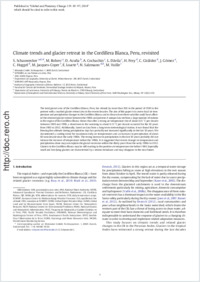Climate trends and glacier retreat in the Cordillera Blanca, Peru, revisited
- Schauwecker, S. Meteodat GmbH, Zurich, Switzerland - Department of Geography, University of Zurich, Switzerland
- Rohrer, M. Meteodat GmbH, Zurich, Switzerland
- Acuña, D. SENAMHI, Lima, Peru
- Cochachin, A. ANA, UGRH, Huaraz, Peru
- Dávila, L. ANA, UGRH, Huaraz, Peru
- Frey, H. Department of Geography, University of Zurich, Switzerland
- Giráldez, C. Department of Geography, University of Zurich, Switzerland
- Gómez, J. SERNANP, ANP Huascarán, Huaraz, Peru
- Huggel, C. Department of Geography, University of Zurich, Switzerland
- Jacques-Coper, M. Institute of Geography, University of Berne, Switzerland
- Loarte, E. Facultad de Ciencias del Ambiente, Universidad Santiago Antúnez de Mayolo, Huaraz, Peru
- Salzmann, Nadine Department of Geography, University of Zurich, Switzerland - Department of Geosciences, University of Fribourg, Switzerland
- Vuille, M. Department of Atmospheric and Environmental Sciences, University at Albany, State University of New York, Albany, USA
-
02.06.2014
Published in:
- Global and Planetary Change. - 2014, vol. 119, p. 85–97
Cordillera Blanca
Glacier change
Climate change
Equilibrium line altitude ELA
Precipitation
Air temperature
English
The total glacial area of the Cordillera Blanca, Peru, has shrunk by more than 30% in the period of 1930 to the present with a marked glacier retreat also in the recent decades. The aim of this paper is to assess local air temperature and precipitation changes in the Cordillera Blanca and to discuss how these variables could have affected the observed glacier retreat between the 1980s and present. A unique data set from a large number of stations in the region of the Cordillera Blanca shows that after a strong air temperature rise of about 0.31 °C per decade between 1969 and 1998, a slowdown in the warming to about 0.13 °C per decade occurred for the 30 years from 1983 to 2012. Additionally, based on data from a long-term meteorological station, it was found that the freezing line altitude during precipitation days has probably not increased significantly in the last 30 years. We documented a cooling trend for maximum daily air temperatures and an increase in precipitation of about 60 mm/decade since the early 1980s. The strong increase in precipitation in the last 30 years probably did not balance the increase of temperature before the 1980s. It is suggested that recent changes in temperature and precipitation alone may not explain the glacial recession within the thirty years from the early 1980s to 2012. Glaciers in the Cordillera Blanca may be still reacting to the positive air temperature rise before 1980. Especially small and low-lying glaciers are characterised by a serious imbalance and may disappear in the near future.
- Faculty
- Faculté des sciences et de médecine
- Department
- Département de Géosciences
- Language
-
- English
- Classification
- Meteorology, climatology
- License
- License undefined
- Identifiers
-
- RERO DOC 211436
- DOI 10.1016/j.gloplacha.2014.05.005
- Persistent URL
- https://folia.unifr.ch/unifr/documents/303750
Statistics
Document views: 138
File downloads:
- sal_ctg.pdf: 501
